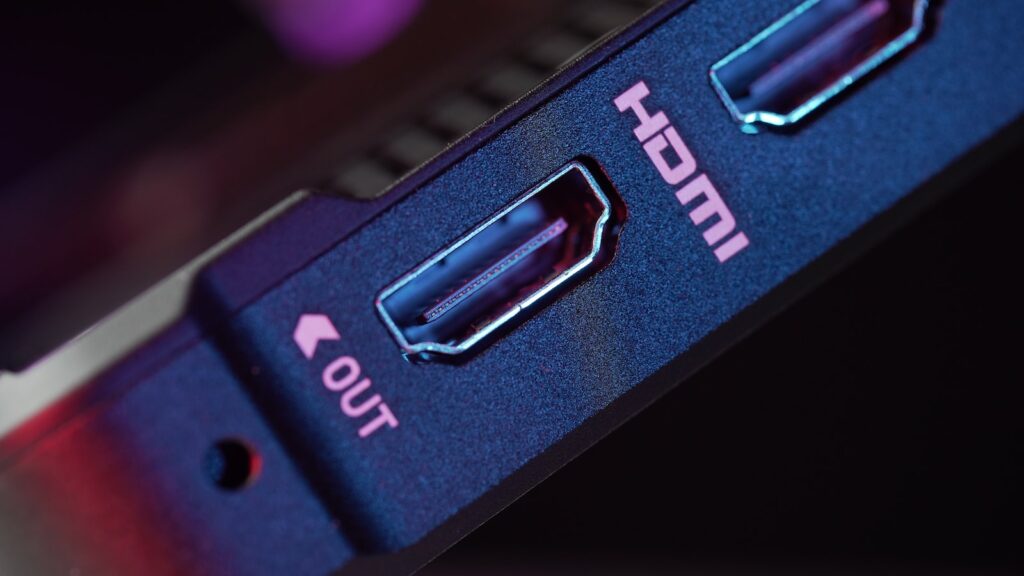
VGA (Video Graphics Array):
VGA is an analog standard that was commonly used to connect monitors to computers. VGA ports are typically blue and have 15 pins arranged in three rows. The standard resolution for VGA is 640×480 pixels, although newer versions of VGA can support higher resolutions. VGA is an older standard that is becoming less common, but can still be found on some computers and projectors.
DVI (Digital Visual Interface):
DVI is a digital standard that was designed to replace VGA. DVI ports can transmit both analog and digital signals, and come in several different types. DVI-D is digital-only, DVI-I is both digital and analog, and DVI-A is analog-only. DVI can support high resolutions, including 1080p and higher. DVI is commonly found on computer monitors and some older graphics cards.
HDMI (High-Definition Multimedia Interface):
HDMI is a digital standard that is commonly used for connecting TVs, monitors, and other audio-visual equipment. HDMI can transmit high-definition video and audio signals, and supports features like 3D and Ethernet connectivity. HDMI is commonly found on TVs, gaming consoles, and media players.
HDMI comes in several different versions, with HDMI 2.1 being the latest and most capable.
- HDMI 1.0 – Introduced in 2002, supports a maximum bandwidth of 4.95 Gbps and resolutions up to 1080p (1920×1080 pixels) at 60Hz.
- HDMI 1.1 – Released in 2004, supports DVD-audio.
- HDMI 1.2 – Released in 2005, supports One Bit Audio, used on Super Audio CDs, up to 8 channels of audio, and 720p/1080i resolutions at 60Hz.
- HDMI 1.3 – Released in 2006, supports a maximum bandwidth of 10.2 Gbps, Deep Color, 10-bit, 12-bit, and 16-bit color depth, and 1080p/1440p/1600p/4K resolutions at 60Hz.
- HDMI 1.4 – Released in 2009, supports a maximum bandwidth of 10.2 Gbps, 3D video, Audio Return Channel (ARC), Ethernet over HDMI, and resolutions up to 4K (4096×2160 pixels) at 24Hz or 30Hz, and 1080p at 120Hz.
- HDMI 2.0 – Released in 2013, supports a maximum bandwidth of 18 Gbps, 4K resolutions at 60Hz, 3D video, HDR (High Dynamic Range), and 32 audio channels.
- HDMI 2.1 – Released in 2017, supports a maximum bandwidth of 48 Gbps, 8K resolutions at 60Hz, 4K resolutions at 120Hz, Dynamic HDR, eARC (enhanced Audio Return Channel), and Variable Refresh Rate (VRR) for smoother gaming.
DisplayPort:
DisplayPort is a digital standard that is similar to HDMI in many ways, but is more commonly used in the PC world. DisplayPort can support very high resolutions and refresh rates, and can transmit audio and video signals over a single cable. DisplayPort is commonly found on high-end graphics cards and some monitors.
DisplayPort comes in several different versions, with DisplayPort 2.0 being the latest and most capable.
- DisplayPort 1.0 – Introduced in 2006, supports a maximum bandwidth of 8.64 Gbps, resolutions up to 2560×1600 at 60Hz, and multiple display support using daisy-chaining.
- DisplayPort 1.1 – Released in 2007, supports a maximum bandwidth of 8.64 Gbps, 10-bit deep color, and resolutions up to 2560×1600 at 60Hz.
- DisplayPort 1.2 – Released in 2009, supports a maximum bandwidth of 17.28 Gbps, resolutions up to 3840×2160 at 60Hz, and multiple display support using daisy-chaining. It also introduced support for Multi-Stream Transport (MST) which allows for multiple displays to be daisy-chained from a single DisplayPort output.
- DisplayPort 1.3 – Released in 2014, supports a maximum bandwidth of 32.4 Gbps, resolutions up to 7680×4320 at 60Hz, and High Dynamic Range (HDR) video.
- DisplayPort 1.4 – Released in 2016, supports a maximum bandwidth of 32.4 Gbps, resolutions up to 7680×4320 at 60Hz, High Dynamic Range (HDR) video, and support for Display Stream Compression (DSC) which allows for higher resolutions and refresh rates with reduced bandwidth requirements.
- DisplayPort 2.0 – Released in 2019, supports a maximum bandwidth of 80 Gbps, resolutions up to 7680×4320 at 60Hz, High Dynamic Range (HDR) video, and support for 4K displays at 144Hz, 5K displays at 60Hz, and 8K displays at 60Hz.
Thunderbolt:
Thunderbolt is a digital standard that was developed by Intel and Apple. Thunderbolt can support very high data transfer speeds and can transmit both video and data signals over a single cable. Thunderbolt ports are compatible with DisplayPort and USB-C devices, and Thunderbolt 4 can support two 4K displays or a single 8K display. Thunderbolt is commonly found on Macs and high-end Windows laptops.
Thunderbolt also comes in different versions:
- Thunderbolt 1 – Introduced in 2011, supports a maximum data transfer rate of 10 Gbps and can support up to two displays with resolutions up to 2560×1600.
- Thunderbolt 2 – Released in 2013, supports a maximum data transfer rate of 20 Gbps, and can support up to two displays with resolutions up to 3840×2160 at 60Hz.
- Thunderbolt 3 – Released in 2015, supports a maximum data transfer rate of 40 Gbps, and can support up to two 4K displays at 60Hz, or a single 5K display at 60Hz. Thunderbolt 3 uses the USB-C connector and is compatible with USB 3.1 and USB 2.0 devices.
USB-C with DisplayPort Alt Mode:
USB-C is a digital standard that is becoming more and more common on laptops, tablets, and smartphones. USB-C can support data transfer, charging, and video signals over a single cable. When used with DisplayPort Alt Mode, USB-C can transmit high-resolution video signals to a monitor or other display. USB-C with DisplayPort Alt Mode is becoming increasingly popular and can be found on many new laptops and smartphones.
Different versions of DisplayPort Alt Mode in USB-C:
- DisplayPort Alt Mode 1.0 – This was the first version of the DisplayPort Alt Mode, introduced in 2015. It supports a maximum resolution of 4K (3840×2160) at 30Hz, or 1080p at 60Hz.
- DisplayPort Alt Mode 1.2 – This version was introduced in 2016 and supports a maximum resolution of 4K (3840×2160) at 60Hz, or 1080p at 120Hz. It also supports High Dynamic Range (HDR) video and 3D video.
- DisplayPort Alt Mode 2.0 – This is the latest version of the DisplayPort Alt Mode, introduced in 2019. It supports a maximum resolution of 8K (7680×4320) at 60Hz, or 4K at 144Hz. It also supports HDR video, Display Stream Compression (DSC), and Multi-Stream Transport (MST) for connecting multiple displays.










































